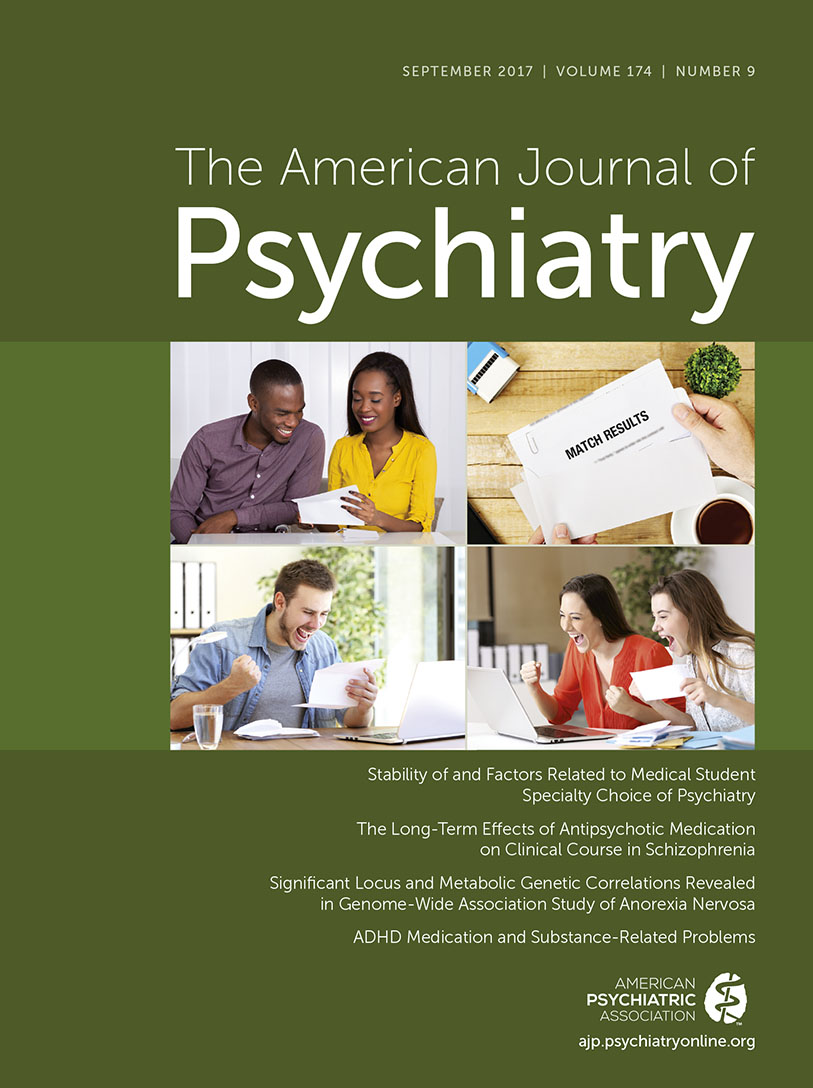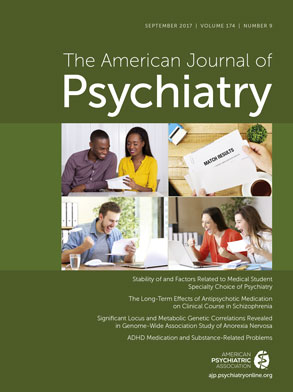Anorexia nervosa is a chronic and often life-threatening illness with stable prevalence across cultures and populations (
1). Once described primarily as a disease with psychological underpinnings, it is now recognized as a biologically based, heritable syndrome. As with other psychiatric disorders (
2), it is likely that many genetic variants, each of very small effect size, contribute to risk for anorexia nervosa. Unlike in several other major psychiatric disorders, progress in the identification of genetic risk factors associated with anorexia nervosa has been slow, and there remains a notable absence of implicated genes with known influence over the brain.
In this issue, Duncan et al. (
3) describe a genome-wide association study (GWAS) of anorexia nervosa and related metabolic phenotypes. The authors combined several case-control data sets for enhanced power to detect effects of common variation on the illness and investigated correlations with other psychiatric, educational, and metabolic phenotypes. The GWAS approaches and genetic analyses follow the current standard rubric, and the results are consistent with what has been reported in other psychiatric disorders at a similar stage of discovery. The results indicate one GWAS significant signal that has previously been linked with type 1 diabetes and autoimmune disorders. Furthermore, the authors report the single-nucleotide polymorphism–based heritability estimates to be significant, suggesting that there is a substantial contribution of common genetic variation to anorexia nervosa. There are a number of genes in the top region of association; the closest of these genes is ERBB3, which binds neuregulin, a gene also implicated in schizophrenia (
4). This finding is consistent with positive genetic correlations noted in the article between anorexia nervosa and schizophrenia. These results are highly consistent with previous reports in the broader psychiatric genetics literature suggesting significant overlap among genetic risk factors for many neuropsychiatric diseases. Indeed, one of the most interesting aspects of this study, and potentially the most informative, is the genetic correlations with multiple other phenotypes of interest that point toward important pathophysiologically relevant overlap among metabolic markers, cognitive/personality traits, and disease. These associations with “intermediate phenotypes” help us understand how a single risk allele might act to influence disease susceptibility in a broad, transdiagnostic manner.
The genetic correlations that are reported between anorexia nervosa and metabolic markers are critically important in emphasizing that this illness is one of both mind and body. However, there are some limitations of the study that prevent the drawing of firm conclusions. The authors emphasize the question of the validity of the links to body mass index, insulin resistance (HOMA-IR), and high-density lipid levels, as these values can all be confounders, depending on the nature of the disease. To further clarify these relationships, significant follow-up would be required, ideally in a study with a group of negative control subjects who experienced significant weight loss but did not have anorexia nervosa. Such a control group would be helpful in delineating what is common among psychiatric and metabolic symptoms and what might be specific to only one of these phenotypes.
While the reported genetic correlation between anorexia nervosa and educational attainment is consistent with past reports, it has previously been described as being related to other factors, such as higher socioeconomic status in families of individuals with anorexia nervosa (
5). These results add to the evidence that these relationships are likely to be influenced by both genes and environment. They also point toward the complex nature of the phenotypes being studied; while educational attainment is thought to be a good proxy for cognitive capacity or intelligence, it almost certainly also reflects other traits, such as neuroticism (
6).
Where do we go from here? The sample size for anorexia nervosa cases is still on the small side for a GWAS, and the authors mention that all available genotyped samples in the world are included here. This raises several questions regarding the impact of the results, which are likely to remain the motivating results in the field for years to come. Based on patterns seen in other major psychiatric illnesses (e.g., schizophrenia and bipolar disorder), how likely is it that the strongest statistical signal (at p<10−9) will remain significant with larger samples? Would we expect to find the same number of common risk variants as is seen in other disorders if sample size continued to increase? If so, how might the field move forward from here? As is often the case, in an effort to increase sample size and power, there is a need to include somewhat heterogeneous cases (e.g., combining restricting type and binge-purging type anorexia nervosa), where there may be different underlying genetic or composite risk factors. This is a minor limitation and one that could be followed up in secondary analyses. Finally, one of the important aspects of the illness that is not discussed in this study is the notable sex imbalance in anorexia nervosa (a 10:1 female-to-male ratio). This will be important to investigate in future work or in subsequent analyses of this data set—for example, utilizing sex-adjusted or sex-specific analyses.
Anorexia nervosa is a difficult-to-treat illness, and there remains a desperate need to develop unique approaches to treat patients with chronic cases of the disorder. The results reported by Duncan et al. support an important new direction for research in this area and will motivate searches into metabolic and immunological factors of the disorder.

